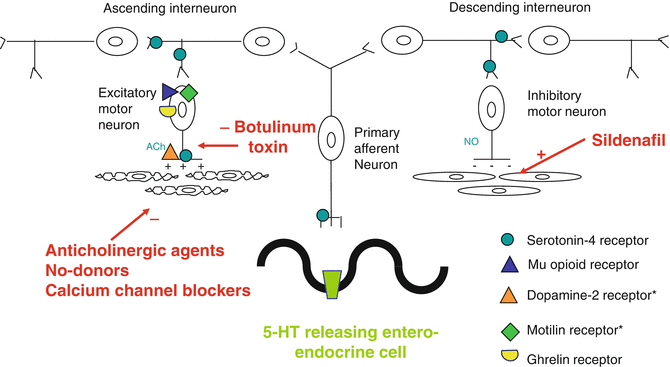, André Smout1 and Jan Tack2
(1)
Gastroenterology and Hepatology, Academic Medical Centre, Amsterdam, The Netherlands
(2)
Gastroenterology and Hepatology, UZ Leuven, Leuven, Belgium
3.1 Introduction
The aim of diagnostic and physiological tests in patients with presumed disorders of gastrointestinal function is to establish a firm diagnosis, which allows specific treatment. However, the number of efficacious and specific treatment modalities for disorders of gastrointestinal function is limited. Very often, the treating physician has to resort to the usage of drugs that were developed for other conditions (off-label use), which may lead to confusion and can be implicated in the occurrence of adverse events. To date, no cure is available for disorders of gastrointestinal function. The therapeutic aim when dealing with disorders of gastrointestinal function is to alleviate the symptom burden associated with these conditions. Treatment approaches are directed either toward changing the contractility of the gastrointestinal tract, its secretory activity, or decreasing sensitivity (perception) of the gastrointestinal tract (Fig. 3.1).


Fig. 3.1
Schematic overview of the control of gastrointestinal contractility through intrinsic neural pathways and potential targets for pharmacotherapy (*only in the proximal gastrointestinal tract: stomach and proximal small bowel)
3.2 Drugs That Enhance Contractility of the Gastrointestinal Tract
Whenever hypocontractility (too few contractions or contractions of too little force) is implicated in the pathogenesis of symptoms, treatments aimed at enhancing contractility can be used.
3.2.1 Direct Stimulation of Gastrointestinal Smooth Muscle
As the most important neurotransmitter involved in generating smooth muscle contraction in the gastrointestinal tract is acetylcholine, so-called cholinomimetic agents can be used. Examples are bethanechol, which mimics the activity of acetylcholine, or neostigmine, which inhibits the degradation of acetylcholine. The use of this class of agents induces direct stimulation of smooth muscle contractility, but this occurs in a non-organ-specific fashion, usually involving the whole gastrointestinal tract. Furthermore, this approach often generates poorly coordinated contractions (which lacks proper coordination of contractile and relaxant activities, as in the peristaltic reflex). Finally, this type of approach often also stimulates acetylcholine receptors outside of the gastrointestinal tract, including receptors on ocular musculature, salivary glands, and sweat glands. Consequently, at levels of effective stimulation of gastrointestinal contractions, adverse events due to non-gastrointestinal receptors often occur. For all of these reasons, the use of this class of agents is largely abandoned.
Tachykinins (including substance P) are a group of peptides that are often released together with acetylcholine, which generate strong contractions of smooth muscle cells. Agonists at tachykinin receptors seem less suitable for treatment of disorders of gastrointestinal function due to the high likelihood of adverse events outside of the gastrointestinal tract (e.g., the respiratory system).
3.2.2 Stimulation of Contractions through Intrinsic Excitatory Nerves
Stimulation of nerves that control contractions is a more attractive target for stimulation of motility, as this is more likely to generate coordinated contractility. Several receptors that are expressed on intrinsic nerves of the gastrointestinal tract are a potential target for this approach. The serotonin-4 receptors, through which motility-enhancing drugs such as metoclopramide, cisapride, tegaserod, and prucalopride are acting, are an important target. They are expressed on nerve cells that generate and coordinate peristalsis and have been shown to enhance contractility from the esophagus to the colon and hence have seen application in gastroesophageal reflux disease, gastroparesis, and constipation.
Dopamine receptors are another suitable target for stimulating motility. Dopamine-2 receptors are mainly expressed in the stomach and the proximal small bowel. Stimulation of these receptors inhibits smooth muscle contractility, and antagonism of the receptors, through the action of drugs such as domperidone, enhances gastric and small bowel contractions. This can be used, for instance, in the treatment of gastroparesis. An additional advantage of this drug class is the involvement of the same dopamine-2 receptor in the generation of nausea and vomiting, and these symptoms can be controlled by dopamine-2 antagonists.
A third type of receptors that allows to enhance motility through stimulation of neural pathways is the motilin receptor, which is also mainly expressed in the stomach and the duodenum. Erythromycin, a well-known antibiotic, activates this receptor and thus stimulates gastric motility at doses which are far below those used for antibiotic purposes. Several variants of erythromycin, devoid of antibiotic properties and with strong stimulatory effects on gastric contractility, have been developed and studied, but the symptomatic benefit of these agents was limited, and to date, none has made it to the market.
Related to the motilin receptor is the ghrelin receptor. It is expressed on nerves in the stomach, the proximal small intestine, and the colon. A number of ghrelin receptor agonists are under evaluation for their ability to provide symptom benefit for disorders of gastrointestinal function.
3.3 Drugs That Inhibit Contractility of the Gastrointestinal Tract
When the presence of excessive contractions or a lack of muscle relaxation underlies symptoms, treatment can be advocated to inhibit contractility or enhance relaxation of smooth muscle.
< div class='tao-gold-member'>
Only gold members can continue reading. Log In or Register to continue
Stay updated, free articles. Join our Telegram channel

Full access? Get Clinical Tree








